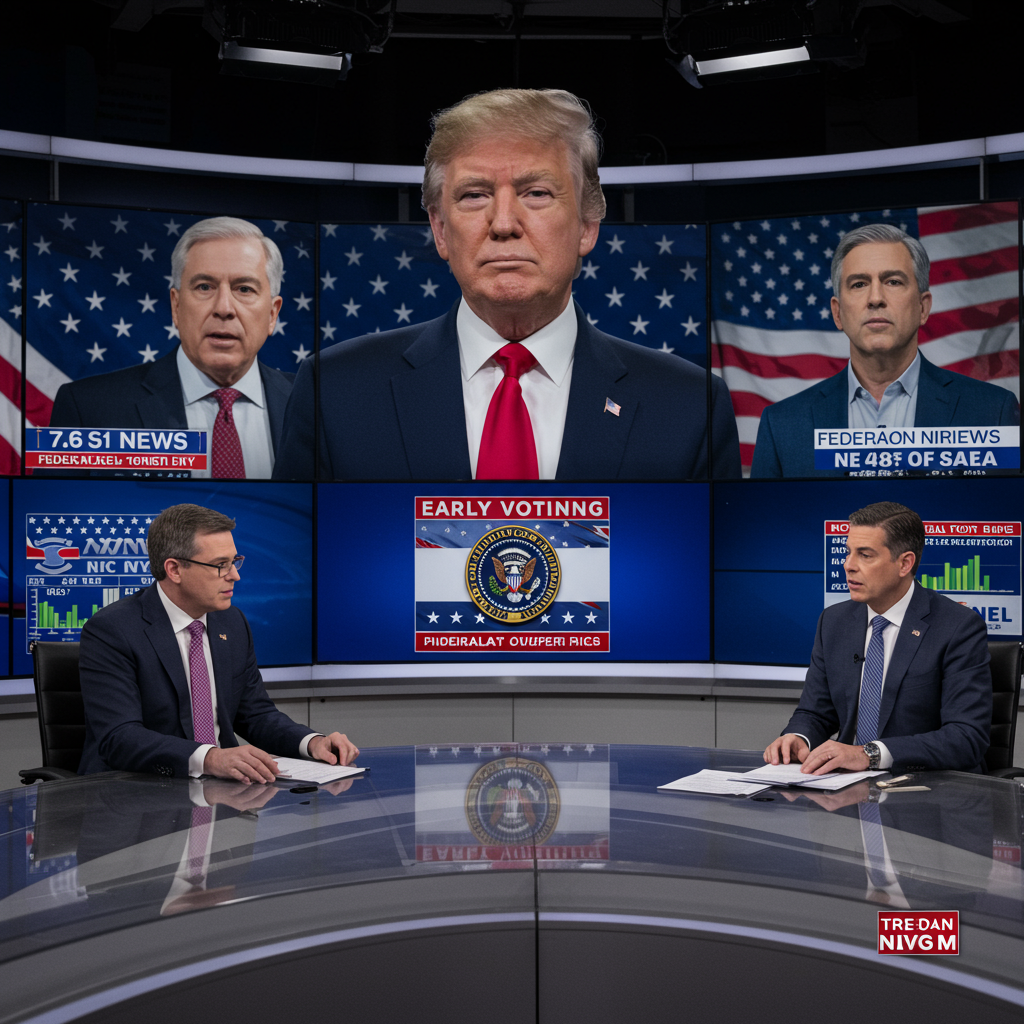As polls close across New York and New Jersey, early voting data offers a critical first look into the highly contested NYC mayoral and NJ gubernatorial races. These pivotal contests, unfolding amidst a federal government shutdown and marking the first general election of President Donald Trump’s second term, are providing crucial insights into the evolving political landscape. An NBC News analysis reveals surprising trends in voter demographics and party performance, hinting at the potential direction of these closely watched elections and their broader national implications.
Early Voting Unlocks Key Insights in Decision 2025
The 2025 off-year elections are far more than local contests; they serve as a crucial barometer for the national political climate. With President Donald Trump in his second term, the outcomes in New York City and New Jersey are being closely scrutinized as either a significant repudiation or a resounding endorsement of his administration’s agenda. The backdrop of a protracted government shutdown further amplifies the stakes, potentially influencing voter sentiment, especially in states with large federal worker populations like New Jersey.
A National Bellwether: Trump’s Second Term Referendum
Political strategists on both sides are keenly observing these results, treating them as a real-time test of President Trump’s influence and the durability of his voter realignment. Early indicators offer a glimpse into how the electorate is responding to national issues, including the economic impact of the government shutdown and debates over energy policy. While official results are still pending and exit polls are yet to be released, the initial voting patterns provide valuable signals for the upcoming 2026 midterms. It’s important to note, however, that crossover voting can complicate drawing definitive conclusions from these early numbers.
New Jersey Governor Race: Democrats Show Early Strength
The race for New Jersey Governor pits Democrat Mikie Sherrill against Republican Jack Ciattarelli, with Ciattarelli aiming to flip the traditionally “blue” state red. Early voting data for the 2025 elections suggests a strong performance by Democrats, who have secured a lead in both mail-in and in-person early voting. This trend contrasts sharply with the 2024 presidential election in New Jersey, where Republicans saw higher in-person early vote turnout, despite Democrats leading in mail-in ballots.
Mikie Sherrill vs. Jack Ciattarelli: The Battle for a Blue State
As of early analysis, nearly 675,000 registered Democrats have already cast their ballots. This demographic represents a larger percentage of the overall early vote compared to their share in the 2024 presidential election. In stark contrast, only around 386,000 registered Republicans have participated in early voting so far. Their current percentage of the total early vote in 2025 is only 93% of what it was during the 2024 early voting period. This significant disparity translates to almost 290,000 more registered Democrats voting early than Republicans in 2025. This Democratic lead going into Election Day 2025 surpasses the 270,000-vote advantage Democrats held before the 2024 presidential race in New Jersey, a contest Vice President Harris won by just over 250,000 votes, or 5.9%. This early “over-performance” by Democrats and “underperformance” by Republicans suggests a potentially challenging Election Day for the GOP in New Jersey. The race was also marred by non-credible bomb threats at several polling sites across multiple counties, which law enforcement quickly debunked, but still caused disruption and raised concerns about voter suppression.
New York City Mayoral Race: Youth Vote Shifts Landscape
In the highly visible New York City mayoral contest, Democrat Zohran Mamdani is identified as the frontrunner. He faces independent candidate and former Governor Andrew Cuomo, alongside Republican nominee Curtis Sliwa. Early voting trends in NYC reveal a notable shift towards a younger electorate compared to the 2021 election. This demographic change could significantly influence the final outcome.
Mamdani, Cuomo, and Sliwa: A Younger Electorate Emerges
Approximately 733,000 voters cast early ballots in the 2025 mayoral election. Of these, a substantial 13.8% were cast by individuals under the age of 30, with another 19.1% coming from voters between 30 and 39 years old. This represents a considerable increase in youth engagement compared to the 2021 election, where only 10.8% of total votes were cast by those under 30, and 15.7% by those between 30 and 40. The early vote is thus skewing significantly younger, signaling a potentially energized new voting bloc. President Trump’s last-minute endorsement of Cuomo, coupled with threats of federal funding cuts if Mamdani wins, has further politicized the race. Mamdani, a self-described democratic socialist, has embraced his progressive platform, advocating policies like rent freezes and government-owned grocery stores, which has resonated with a younger, more left-leaning base. This contest is seen as a key test for the viability of progressive politics in a major urban center.
Beyond the Ballot Box: Broader Political Implications
These off-year elections are not just about who wins; they are about understanding the evolving political landscape. President Trump’s active engagement, even without being on the ballot, underscores the pervasive nature of his influence. His endorsements, criticisms, and calls to action are shaping narratives and voter turnout. For Republicans, observing vote margins helps refine strategies for the 2026 midterms, while Democrats are testing different approaches to reclaim ground lost in previous cycles.
The Trump Realignment Test & Shifting Democratic Strategies
The 2025 elections are seen as a critical test for the “Trump realignment,” following shifts to the right in key demographics in 2024. Trump’s increased popularity among segments like labor union members, Black men, Hispanic voters, and younger people makes states with high union households, like New Jersey, particularly vulnerable for Democrats. Meanwhile, the Democratic Party itself is grappling with two distinct philosophies: a moderate approach versus embracing progressive policies. Candidates like Mikie Sherrill in New Jersey have emphasized economy, public safety, and healthcare, deliberately distancing themselves from more left-leaning platforms. Conversely, Zohran Mamdani in NYC fully embraces democratic socialism, signaling a different path forward. The broader context includes significant legislative battles, such as California’s Proposition 50, which aims to redraw congressional maps to favor Democrats, directly countering Republican redistricting efforts.
Government Shutdown, Voter Security, and National Echoes
The federal government shutdown, now spanning over a month, has a tangible impact, particularly in states like Virginia and New Jersey, where federal workers face furloughs or unpaid work. This could fuel voter dissatisfaction and swing close elections. Concerns over election integrity also surfaced, with non-credible bomb threats at New Jersey polling places and reported “swatting schemes” in NYC, prompting swift law enforcement responses. These incidents, though deemed not credible, highlight ongoing tensions around voter security and potential attempts at suppression. The outcomes here will undoubtedly inform national party strategies and messaging as the 2026 midterms approach.
Frequently Asked Questions
What do early voting trends reveal about the NYC mayoral and NJ gubernatorial races?
Early voting data indicates a strong performance by Democrats in New Jersey, with nearly 290,000 more registered Democrats voting early than Republicans, surpassing their lead from the 2024 presidential election. In New York City, the early vote is significantly younger than in previous elections, with a higher percentage of ballots cast by those under 40, suggesting a potential shift in the electorate’s demographics. These trends offer initial insights into voter engagement and party preference ahead of official results.
How does the early vote in New York City reflect a younger electorate compared to previous elections?
In the 2025 NYC mayoral election, almost 733,000 early ballots were cast. A notable 13.8% came from voters under 30, and 19.1% from those aged 30-39. This marks a significant increase compared to the 2021 election, where only 10.8% of votes were from those under 30 and 15.7% from 30-40 year olds. This indicates a substantial skew towards a younger demographic participating in early voting for the current mayoral contest, potentially impacting the race’s final outcome.
Why are these 2025 off-year elections considered a critical test for President Trump’s second term?
These elections, held during President Trump’s second term and amidst a federal government shutdown, serve as a direct referendum on his administration’s agenda and influence. The outcomes in key races like New York City mayoral and New Jersey gubernatorial are being interpreted by both parties as either an endorsement or a repudiation of his policies and leadership. They provide early indicators of voter sentiment, the strength of Trump’s realignment, and the effectiveness of Democratic strategies, setting the stage for the crucial 2026 midterm elections.
Conclusion: What Early Trends Signal for the Road Ahead
The early voting insights from the New York City mayoral and New Jersey gubernatorial races offer a compelling preview of the current political landscape. While definitive winners are yet to be declared, the data points to energized Democratic early voting in New Jersey and a distinctly younger electorate driving turnout in New York City. These trends, framed by the implications of President Trump’s second term and an ongoing government shutdown, underscore the high stakes of these seemingly “off-year” elections. The results will undoubtedly inform national strategies, shaping narratives and campaign approaches as both parties prepare for the critical electoral battles of 2026 and beyond.


